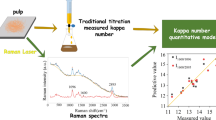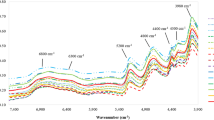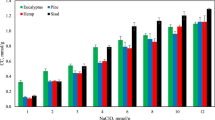Abstract
The present study was attempted to develop a suitable method for determining dissolving pulp properties such as pentosan, α-cellulose, R10, R18, viscosity, and brightness. In this study, properties are quantified first with wet chemical methods. Then, spectroscopic data of the samples were collected after running them through UV spectrophotomer and Fourier transformed-near infrared (FT-NIR) spectrophotometer. Spectroscopic data from both the instruments were pretreated with normalization, baseline correction, smoothing, Standard Normal Variate (SNV), Savitzky-Golay (S-G) smoothing with their first and second derivatives, and their combinations. Predictive models were calibrated with raw data and pretreated data from both the instruments. Results show that PLSR produce better predictive efficiency than PCR both with UV and FT-NIR data of their raw and pretreated form. In dissolving pulp, α-cellulose and R10 could be quantified with UV data treated by smoothing with moving average and S-G (first derivative) (R2 ≈ 99%) and baseline correction and smoothing with moving average (R2 ≈ 96%). Brightness could be determined with PLSR with FT-NIR raw data (R2 ≈ 92%). For R18 and viscosity, PLSR could be used FT-NIR data treated by baseline correction and smoothing with moving average (R2 ≈ 75%) and baseline correction and normalization (R2 ≈ 68%). The proposed chemometric method with pretreated spectroscopic data is a simple, rapid, and cost effective technique to determine properties of dissolving pulp.








Similar content being viewed by others
References
Christov LP, Akhtar M, Prior BA (1996) Short note impact of xylanase and fungal pretreatment on alkali solubility and brightness of dissolving pulp. Holzforschung 50:579–582
Jahan MS, Mun SP, Rashid M (2004) Fiber dimensions and chemical properties of various nonwood materials and their suitability for paper production. TAPPI J 36(5):29–35
Sarkar M, Sutradhar S, Sarwar AKMG, Uddin MN, Sontosh CC, Jahana MS (2017) Variation of chemical characteristics and pulpability of dhaincha (Sesbaniabispinosa) on location. J Bioresour Bioprod 2(1):24–29
Okan OT, Deniz I, Tiryaki S (2015) Application of artificial neural networks for predicting tensile index and brightness in bleaching pulp. J Bioresour Bioprod 17(3):571–584
Lavalle L, Sommer AJ, Peterson RC (2001) Evaluation of the use of infrared spectroscopy and multivariate analysis as tools for pulp characterization. TAPPI Pulping Conference
Yeh T, Yamada T, Capanema E, Chang H, Chiang V, Kadla JF (2005) Rapid screening of wood chemical component variations using transmittance near-infrared spectroscopy. J Agric Food Chem 53:3328–3332
Poke FS, Raymond CA (2006) Predicting extractives, lignin and cellulose contents using near infrared spectroscopy on solid wood in Eucalyptus globulus. J Wood Chem Technol 26(2):187–199
Huang C, Han L, Liu X, Ma L (2011) The rapid estimation of cellulose, hemicellulose, and lignin contents in rice straw by near infrared spectroscopy. Energ Source Part A 33:114–120
Maria F, Juraj G, Albert R, Marta M (2012) Using NIR analysis for determination of hardwood kraft pulp properties. Wood Res-Slovakia 57:121–130
Santos AJA, Anjos O, Pereira H (2015) Estimation of Acacia melanoxylon unbleached Kraft pulp brightness by NIR spectroscopy. Forest Syst 24(2):1–6
Li X, Sun C, Zhou B, He Y (2015) Determination of hemicellulose, cellulose and lignin in moso bamboo by near infrared spectroscopy. Sci Rep 5:17210 1-11
Kothiyal V, Jaideep BS, Ginwal HS, Gupta S (2015) Multi-species NIR calibration for estimating holocellulose in plantation timber. Wood Sci Technol 49:769–793
Colares JGC, Pastoreb CMT, Coradinb TRV, Camargosb AAJ, Moreirab COA, Rubimb CJ, Bragaa WBJ (2015) Exploratory analysis of the distribution of lignin and cellulose in woods by Raman imaging and chemometrics. J Braz Chem Soc 26(6):1297–1305
Silva JC, Nielsen BH, Rodrigues J, Pereira H, Wellendorf H (1999) Rapid determination of the lignin content in Sitka spruce (Piceasitchensis (Bong.) Carr.) wood by Fourier transform infrared spectrometry. Holzforschung 53:597–602
Uddin MN, Roy SK, Islam MS, Nayeem J, Jahan S (2017) Development of method for rapid prediction of chemical components of Dhaincha using FT-NIR spectroscopy and chemometrics. J For 6(4):22–28
He L, Xin LP, Chai XS, Li J (2015) A novel method for rapid determination of α-cellulose content in dissolving pulps by visible spectroscopy. Cellulose 22(4):2149–2156
Nayeem J, Sarkar M, Quadery AH, Jahan MS (2017) High purity dissolving pulp from jute. Nord Pulp Pap Res J 32(4):620–626
Paavilainen L, Torgilsson R (1994) Tappi pulping conf. proces, November 6–10, San Diego, CA, USA, Tappi Press, Atlanta, GA, USA
Brown SD, Ferre RT, Walczak B (2009) Comprehensive chemometrics: data preprocessing, linear soft-modeling, unsupervised data mining. Elsevier, Science Publishers, V, New York
Brereton RG (2002) Chemometrics: data analysis for the laboratory and chemical plant. Wiley, West Sussex
Massart DL, Vandeginste, Deming SN, Michotte Y, Kaufman L (1988) Chemometrics: a textbook. Elsevier, Science Publishers, V, New York
Jolliffe IT (2002) Principal component analysis, 2nd edn. Springer, New York
Wold S, Sjöström M, Eriksson L (2001) PLS-regression: a basic tool of chemometrics. Chemom Intell Lab Syst 58(2):109–130
Kramer R (1998) Chemometric techniques for quantitative analysis. Marcel Dekker, Inc., New York
Jahan MS, Islam MK, Chowdhury DN, Moeiz SI, Arman U (2007) Pulping and papermaking properties of pati (Typha). Ind Crop Prod 26(3):259–264
Author information
Authors and Affiliations
Corresponding authors
Additional information
Publisher’s note
Springer Nature remains neutral with regard to jurisdictional claims in published maps and institutional affiliations.
Rights and permissions
About this article
Cite this article
Uddin, M.N., Nayeem, J., Islam, M.S. et al. Rapid determination method of dissolving pulp properties by spectroscopic data and chemometrics. Biomass Conv. Bioref. 9, 585–592 (2019). https://doi.org/10.1007/s13399-019-00383-8
Received:
Revised:
Accepted:
Published:
Issue Date:
DOI: https://doi.org/10.1007/s13399-019-00383-8




